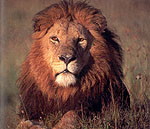LION

How to Recognize
Lions are the largest and most powerful predator in the world. Itís a magnificent animal that appears as symbols of power, courage, and nobility on family crests, coats of arms, and national flags in many civilizations.
They have fawn to tawny colored coats with black to golden manes. The male is much larger than a female and has a huge shaggy mane that encircles the head and neck. The tails of lions end in a horny spine covered with a tuft of hair. A cubís spots eventually fade with age.
A lionís jaw can easily bite through muscle and bone, often leaving little more than the head and spine of their prey intact. A few have killed humans, but attacks are very rare and are usually made by old or injured lions.
Habitat
Lions can be found in all habitats except deserts and thick forests. These include grasslands, savannas, and woodlands. They use cover to ambush prey and hide cubs.
Behavior
Nocturnal and diurnal. Lions spend much of the night hunting, patrolling their territories, and playing. They keep in contact with one another by roaring loud enough to be heard up to five miles away. Many hunts take place just after dawn. Most of the day (16 to 20 hours) are spent sleeping and lazing around in the shade. When resting, lions enjoy good fellowship with lots of touching, head rubbing, licking, and purring.
Lions are strictly territorial, defending ranges from 20 to 150 square miles. Young males are ousted from the pride when they are two to three years old, entering a period of nomadism that ends at around the age of five. They are then able to take over a pride of their own.
A pride can consist of up to thirty lions, with the core being between four to twelve related females. One or more dominant males share mating rights and food with these females. The females cooperatively stalk and ambush prey, doing 85% to 90% of the hunting. But when it comes to the food, each lion looks out for itself. Squabbling and fighting are common, with males usually eating first, followed by the females, and then the cubs.
In return, males ward off attacks by nomadic males looking to dominate a pride. If a nomadic male wins, he will kill the cubs in the pride. This sends the females into estrus, and the new males gets to enjoy fatherhood and a hunting pride.
Breeding
Females mate two to three times per hour for less than a minute for two to six days. They suckle each otherís young. Two to six cubs are born in a hidden den after a 3Ĺ month gestation period. They join the pride after four to eight weeks.
Feeding
Some lion prides specialize in buffaloes, others in giraffes, but most usually hunt impalas, wildebeests, and zebras. They also eat young elephants, rhinos, hippos, warthogs, antelopes, and even crocodiles.
Curious or hungry lions will eat rodents, lizards, tortoises, and ostrich eggs. They normally ambush prey within 30 yards and suffocate their victims by biting their throats. Hunts are successful about half the time.
They also follow vultures to kills. Because they often take over kills made by hyenas, cheetahs, and leopards, scavenged food provides more than 50% of their diets in areas like the Serengeti plains.
Enemies
Humans. Lions have been killed in rituals of bravery, as hunting trophies, and for their medicinal and magical powers.
TOP OF PAGE
Copyright © 2002, Dawn M. Dalton.
All rights reserved.
**LINKS**
WHERE?
WHY?
ITINERARY
PLAN YOUR TRIP
GETTING THERE
LONDON
KENYA
UGANDA
SAFETY
ITEMS BOUGHT
STAYING HEALTHY
COMMENTS
HOME
BHS HOME
---Animal Facts--
Baboon
Buffalo
Cheetah
Chimpanzee
Crocodile
Eland
Elephant
Gazelle
Giant Forest Hog
Giraffe
Gorilla
Hippopotamus
Hyena
Hyrax
Impala
Jackal
Lion
Mongoose
Monkey
Ostrich
Rhinoceros
Topi
Uganda Kob
Warthog
Waterbuck
Wildebeest
Zebra